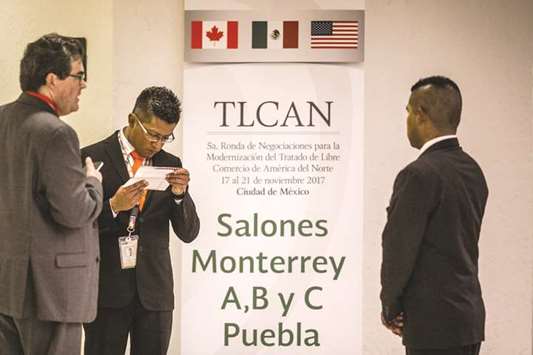The Trump administration reiterated its goal to reduce the trade deficit with its Nafta partners in revised negotiating objectives, while adding in proposals it made during talks that were opposed by Canada and Mexico.
The US wants reciprocal market access for manufactured goods as part of its push to improve its trade balance with Canada and Mexico, the office of the US Trade Representative said on Friday in updating its objectives for negotiating the North American Free Trade Agreement. The government must keep Congress informed of its plans under a law that gives the administration the authority to negotiate trade deals.
The US had a $63bn trade deficit in goods and services with Mexico last year, and a $7.7bn surplus with Canada, according to US government figures. The parties are meeting through November 21 in Mexico City for the fifth round of talks, which began in August at the insistence of the Trump administration.
The new version of US objectives puts into ink several demands already reported to have been made in recent rounds. That includes provisions to seek what had been considered effectively a sunset clause — though the US called it on Friday “a mechanism for ensuring that the parties assess the benefits of the agreement on a periodic basis” and didn’t specify any proposal for automatic termination — and to essentially make certain dispute panels non-binding.
The objectives reiterated the US wants to eliminate chapter 19 of the agreement, which empowers bi-national panels of judges to review cases in which companies are accused of selling their products below fair value, or of receiving unfair subsidies.
The latest version also says the US wants “reciprocity” in procurement with Canada and Mexico, essentially confirming a demand that would claw back access to the US market.
It takes aim at Canadian dairy in particular, saying the US wants to kill Canada’s tariffs on poultry, dairy and eggs, a measure that would effectively dismantle Canada’s system of supply management that would be fiercely opposed by the government.
It calls for the US to keep “non-conforming” measures for long-haul trucking that could curtail Mexican access to the US, and includes several new demands on the chapter in investment and competition.
The objectives also insert language about increasing transparency in “import and export licensing procedures” and cracking down on “import and export monopolies” to prevent trade distortions, as top line goals for improving America’s goods trade-deficit.
USTR first published its negotiating goals on July 17 before official three-way talks began.
US Trade Representative Robert Lighthizer and his Canadian and Mexican counterparts, Chrystia Freeland and Ildefonso Guajardo, were not attending this round, an approach that officials hope will dial down the political rhetoric and allow bureaucrats to move the ball forward on issues where the nations have common ground.
Still, Trump and his trade deputies haven’t backed down from the threat to withdraw the US from the 23-year-old accord, which governs more than $1tn in annual trade and has shaped the supply chains of companies from General Motors Co to Caterpillar Inc.
Commerce Secretary Wilbur Ross said last week the talks are “on a very short time fuse” as a general election in Mexico and Congressional elections in the US approach next year.
Several of the blue-collar states key to Trump’s victory, including Michigan, Ohio, Pennsylvania, Wisconsin and Indiana, would be hit hardest if the US walks away from the deal, the US Chamber of Commerce said on Friday in an analysis. Other big losers would include North Dakota, Texas, Missouri, Iowa, Arizona, Nebraska and North Carolina, said the group, the largest business organisation in the US.
With 65% of its exports heading to Mexico and Canada, Michigan could suffer from the most with about 366,000 jobs at risk if Nafta collapses, the chamber’s senior vice-president for International Policy John Murphy said in a blog post.
The US would lose 187,000 jobs that rely on exports to Mexico and Canada, with the auto industry most affected, the Peterson Institute for International Economics said in a separate analysis. However, the study also noted that 7.4mn US workers lost or left their jobs between 2013 and 2015 because their plant or company closed or moved, there wasn’t enough work to do, or their position vanished.
Some estimates of Nafta’s demise haven’t been so dire. Moody’s Analytics projects that withdrawal would hurt all three economies, with Mexico the most vulnerable. But none of the three would slip into recession, according to Moody’s forecasts.
Negotiators are set to pay highest attention to rules of regional content, including for cars, as well as financial services in this round, according to an agenda obtained by Bloomberg.
One of the most contentious US proposals focuses on the so-called rules of origin for cars, which govern how much of a vehicle must be produced in North America to trade without tariffs. The Trump administration called for increasing the regional content requirement to 85% from 62.5%, and added a 50% minimum for US content.
Another contentious US proposal is adding a sunset clause, which would automatically terminate the pact after five years unless the parties agree to extend it. Ahead of this round, Mexico backed a five-year review of the deal without a withdrawal clause.
Canada is open to discussing the Mexican proposal and to the idea of some kind of periodic re-examination, but considers a full sunset clause as proposed by the US to be a non-starter, according to a Canadian government official speaking on condition of anonymity.

Security officers stand during the fifth round of Nafta renegotiations in Mexico City on Friday. The US wants reciprocal market access for manufactured goods as part of its push to improve its trade balance with Canada and Mexico, the office of the US Trade Representative said, updating its objectives for negotiating an agreement.


